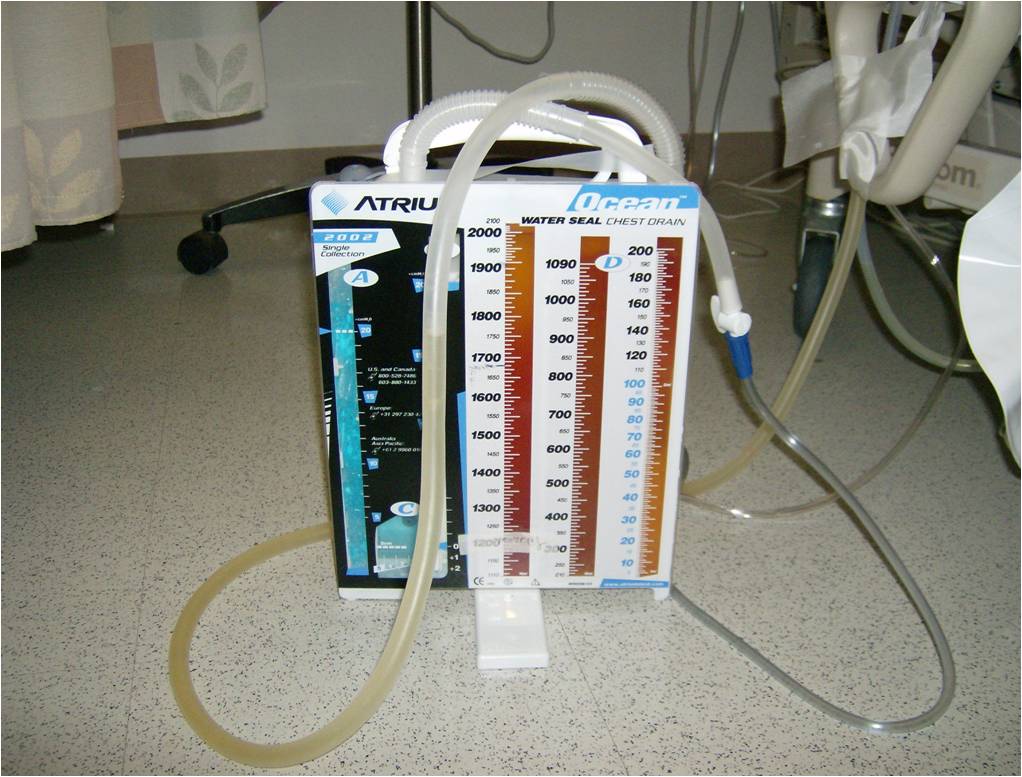Chest tubes are medical devices that are placed in the chest to drain air, blood, or other fluids from the pleural cavity. They are used to treat conditions such as pneumothorax, hemothorax, or pleural effusion. Chest tubes are connected to a drainage system that allows fluids to be removed from the chest and into a collection container. One important aspect of chest tube management is monitoring the presence of tidaling.
Tidaling refers to the movement of fluid in the water-seal chamber of the chest tube drainage system. During normal breathing, the pressure in the pleural cavity changes, causing the fluid in the water-seal chamber to move up and down. This movement is called tidaling. It is an important indicator of the proper functioning of the chest tube system.
The presence of tidaling indicates that the chest tube is patent and that air or fluid is beng removed from the pleural cavity. The absence of tidaling may indicate a problem with the chest tube or drainage system. For example, if there is no tidaling, the tubing may be occluded by a clot or kink, or the lung may be fully re-expanded.
It is important for healthcare providers to monitor tidaling on a regular basis. This can be done by observing the water-seal chamber of the chest tube drainage system. The water level should rise with inhalation and fall with exhalation. This demonstrates that the chest tube is patent and that air or fluid is being removed from the pleural cavity.
In addition to monitoring tidaling, healthcare providers should also assess the drainage system for other signs of proper functioning. Bubbles in the water-seal or air leak chamber may indicate an air leak. Continuous bubbling may indicate a significant air leak, and newer systems have a measurement system for leaks—the higher the number, the greater the air leak.
In wet suction systems, gentle bubbling may occur as the lungs expand. This is normal. However, any bubbles in a dry suction system suggest an air leak. Tidaling is not evident when the chest drainage unit is attached to suction.
Tidaling is an important indicator of the proper functioning of chest tubes. It is important to monitor tidaling on a regular basis to ensure that the chest tube is patent and that air or fluid is being removed from the pleural cavity. Healthcare providers should also assess the drainage system for other signs of proper functioning, such as the presence of bubbles in the water-seal or air leak chamber. By monitoring tidaling and other signs of proper functioning, healthcare providers can ensure the safety and well-being of their patients.
What Does No Tidaling Mean?
No tidaling refers to the absence of fluctuations in the water-seal chamber during respiratory effort. This could indicate that the tubing is occluded by a clot or kink, or that the lung has fully re-expanded. Tidaling is a normal occurrence in the water-seal chamber during normal breathing, as the air in the chest cavity moves in and out with each breath. However, the absence of tidaling could also indicate a problem with the chest tube, so it is important to monitor this closely. If there are concerns, it is recommended to seek medical attention.

Is Chest Tube Tidaling Normal?
Chest tube tidaling is a normal phenomenon. Tidaling refers to the fluctuations in the water-seal chamber of a chest tube with respiratory effort. During spontaneous inspiration, the water level in the chamber increases, and during expiration, it decreases. This is because the negative pressure generated during inspiration causes air to enter the pleural space, which pushes the fluid in the water-seal chamber towards the drainage canister. During expiration, the positive pressure in the pleural space pushes the fluid back into the water-seal chamber. These fluctuations are typically seen in patients who have chest tubes in place and are breathing spontaneously. It is important to note that the absence of tidaling does not necessarily inicate a problem with the chest tube, but instead could be due to a lack of respiratory effort or a blocked tube.
What Does Tidaling In A Chest Tube Indicate?
Tidaling in a chest tube refers to the rise of water in the water-seal chamber during inhalation and its fall during exhalation. This movement of the water demonstrates that the chest tube is patent, which means that it is open and functioning properly. Tidaling is an important sign that indicates the proper functioning of the chest tube, and it should be observed regularly. Continuous bubbling may indicae an air leak, and newer systems have a measurement system for leaks. The higher the number, the greater the air leak. Therefore, the observation of tidaling is crucial in monitoring the patient’s condition and ensuring that the chest tube is working correctly.
How Do You Assess Tidaling?
To assess tidaling, you need to inspect the water-seal chamber and/or drainage tubing for any movement of water with respirations. In wet suction systems, you may notice gentle bubbling as the lungs expand, wich is normal. However, in dry suction systems, any bubbles indicate an air leak, which is not normal.
It’s important to note that tidaling is not visible when the chest drainage unit is attached to suction. Therefore, it’s crucial to check for tidaling when the unit is not under suction.
Conclusion
Tidaling is a normal and important phenomenon to observe when monitoring a patient with a chest tube. It refers to the fluctuations in the water-seal chamber with respiratory effort, which demonstrates that the chest tube is patent and the patient’s lungs are functioning properly. It is important to know what to look for when assessing tidaling, as continuous bubbling may indicate an air leak and require further intervention. Additionally, newer chest drainage systems have a measurement system for leaks, which can be helpful in determining the severity of the situation. As a healthcare provider, it is crucial to monitor tidaling and any signs of abnormality to ensure the best possble outcomes for the patient.
